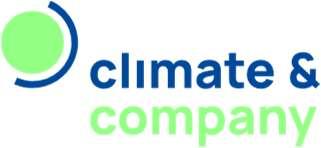
laura@climcom.org +43(0)69010090655
Publicconsultation FeedbackonthevoluntarySME standard Climate&CompanygGmbH
Climate&Company Climate&Company-theprivateinstitutefor climateresearchandtraininggGmbH Ahornallee2 12623Berlin Contactperson: LauraKaspar

Projectpresentation:Workshopseriesontheintroductionofthe voluntarySMEstandard
FromFebruarytoMay2024,Climate&CompanyhasorganisedaseriesofworkshopsintheStuttgart areaincooperationwiththeBaden-WürttembergMinistryofEconomicAffairs,LabourandTourism. Theaimofthisinitiativeistofamiliarise5-10SMEsintensivelywithEFRAG'sdra voluntarySME standard.Theworkshopswillenabletheparticipatingcompaniestoimplementthenecessaryinternal datacollectionprocessesforsustainabilityreporting.Theywillalsohavetheopportunitytotakepart inafieldtestandinthepublicconsultationofthevoluntarySMEstandardbyEFRAG.
AkeyoutcomeofthisprojectisthecreationofaguideforGermanSMEsonimplementingthe voluntarySMEstandard.Thisguidewillcontainsimplifiedandabridgedversionsofthestandard's requirementtextsaswellasimportanttips,assistanceandpracticalexamplestomakethereporting processeasierforcompanies.
SixkeymessagesonthevoluntarySMEstandard
1. Overburdenedbyexternaldatarequests:SMEsfacethechallengeofusingdifferent platformsfortheircustomers'datarequestsandkeepingthemuptodate.Thefulfilmentof sustainabilityrequirements,especiallyfrommajorcustomers,iso ennotonlydemandingbut alsoadministrativelycomplex.Suchdatarequestscanleadtoconsiderablemanagement effortandevenresultinprojectlossesiftheinformationisprovidedlate.Wetherefore welcomeEFRAG'sinitiativetodesignthevoluntarySMEstandardinsuchawaythatitenables moresystematicdatacollection.ThiscouldhelpSMEstorespondmorequicklyandefficiently toexternalenquiries.
2. ChallengesinmaterialityanalysisforSMEs:SMEsfaceconsiderabledifficultieswhen carryingoutmaterialityanalyses.Theyo enfinditdifficulttoweighuptheimportanceof differentaspects,suchasdecidingwhetherthereductionofgreenhousegasemissionsismore importantthanthecontributiontothecirculareconomy.Inaddition,identifyingthekeyissues fortheirsectoriso encomplex.Againstthisbackground,specific,sector-basedsupportis essential.ThisshouldaimtoprovideSMEswithaclearerunderstandingofthematerial aspectsrelevanttotheirsectorandhelpthemtoaccuratelyrecordandevaluatethem.
3. Problemoffragmentationofsustainabilitytopics:Thecurrentmodulestructureinthe SMEstandardleadstoanunnecessaryfragmentationofsustainabilitytopics,whichare typicallyreportedinbundlesinpractice.Forexample,informationonwasteorgreenhousegas emissionsisscatteredacrossseveralmodules.Atpresent,thereisnoproposalfora thematicallybundledandstandardisedstructureforSMEsustainabilityreportsthatwould increaseuserandreaderfriendliness.
4. IncreasedneedforsupportforSMEs:Clearerdefinitions,policiesandpracticalexamples areneededtoeffectivelysupportSMEsintheirsustainabilityreporting.Particularlyinareas suchasemissionscalculationandthecirculareconomy,therequirementsneedtobeclarified andsupplementedwithassistancetomakeiteasierforSMEstoimplementsustainability practices.
5. Promoteflexibilityanddifferentiationinreporting:TheSMEstandardshouldincreasingly callforflexiblereportingthatdoesjusticetothewiderangeofcompanysizesandbusiness modelsintheSMEsector.Forexample,thebusinesspartnermodulelacksanexplicitrequest

toanalysepastrequestsforinformationfromimportantstakeholders(especiallymajor customersandfinanciers)andtocollectandreportregularlyrequestedinformationina bundledform.Thiswouldenablecompaniestorespondmorespecificallytoindividual requirementsandminimiseadministrativeburdens.
6. Interactionbetweenlegislationandreporting:Forsomedisclosurerequirements,the addedvalueofreportingisnotobvious.Thisisthecase,forexample,withcommitmentsand disclosuresonhumanrightsrelatingtothecompany'sownworkforce,astheseaspectsare alreadyautomaticallyandmandatorilyfulfilledbycompliancewithEuropeanandnational legislation.Thesameappliestotheentitlementtoleaveforfamilyreasons.
Feedbackonthestructureofthestandard
ThestructureofthestandardinthethreemodulesBasic,NarrativeandBusinessPartnerislogical, consideringthediversityofSMEsintermsofemployeenumbers,capacitiesandprogressin sustainabilitytransformation.However,thedivisionintomodulesleadstoafragmentationof sustainabilitytopicsthatbelongtogetherintermsofcontent.
Example1:Climatemathematicscanbefoundinallthreemodules
BasicModuleB3:Energyconsumptionandgreenhousegasemissions
NarrativemoduleN3:Measurestoimproveenergyefficiencyandreducegreenhousegas emissions
BusinesspartnermoduleBP4:Transitionplantomitigateclimatechange
Example2:Wastemanagementduplicatesitselfandislocatedinboththebasicandbusinesspartner modules
BasicmoduleB7c:Totalannualwastegeneration,brokendownbytype(hazardous/nonhazardous)
BusinesspartnermoduleBP6:Totalamountofhazardousand/orradioactivewaste generated
Inpractice,thisinformationisusuallyreportedinsummarisedform.Thelackofbundlingof thematicallysimilardisclosuresintheSMEstandardmakescoherentandintuitivereportingdifficult. EFRAGshouldexplainhowtherequiredinformationcanbestructuredinastandardisedsustainability report.Astructuredtemplatethatcategorisesdisclosuresfromallmodulesundertheclassictopicsof environment(E),social(S)andgoodcorporategovernance(G)wouldbeadvantageoushere.This categorisationwouldnotonlyensurethatthematicallyrelatedinformationisnotreportedina scatteredmanner,butwouldalsosimplifythepreparationprocessforcompaniesandestablisha uniformandintuitivelycomprehensiblesequenceofsustainabilityreportingbyEuropeanSMEs.
Table1containsastructuraltemplateforSMEsustainabilityreports,whichisbasedonexisting practiceintermsofthematicseparation.Thelongversioncanbefoundintheannexandassignsthe individualdisclosuresofallmodulestothetopicsproposedhere.
Table 1Structure template for SME sustainability reports
Basics Materialityanalysis

Stakeholders
Environment
Energy&Climate
Pollution
Biodiversity
Water
Circulareconomy&waste
Climaterisksforthecompany
Social
Informationontheworkforce
Humanrights
Governance
Approachesandpolicies
Selectedmetrics
Companiesshowvaryingdegreesofambitionintheirsustainabilityreportingdependingonthearea.It isthereforeimportantthattheydonotreportexclusivelyaccordingtothebasicmodule,butalsohave thefreedomtoreportinmoredetailincertainareas.Thisallowsthemtoaddressmaterialinformation thatmightotherwisebeomitted.
Companiesshouldbecontinuallyencouragedtodecideindividuallywhichtopicstoemphasiseand whichtoomitintheirreports.Anoptionforadditionaldisclosuresintheformofanemptyboxcould behelpfultoallowcompaniestoincludespecificinformationthatrespondsdirectlytorequestsfrom stakeholders,suchasbanks.Companiesknowtheirownneedsandrequirementsbestandshould thereforebeabletocustomisetheirreportsaccordingly.
Feedbackontheindividualmodules
Basicmodule
Inthebasicmodule,whichmainlyconsistsofkeyfigures,user-friendlinessshouldbeincreasedwitha viewtothefinaloutput,the"sustainabilityreport",throughadditionalsupportmeasures.We suggestincludingexplicitnotesinthemodulethatencourageuserstoprovideexplanationsand contextfortherespectivekeyfigures.Thiswouldhelpusersnotonlytoreportthedata,butalsoto categoriseandinterpretitinameaningfulway.
Wealsorecommendprovidingmorelow-thresholdexplanationsofbasicsustainabilityconcepts, suchasthewastehierarchyanddifferenttypesoflanduse.Theseshouldbecomplementedby hyperlinkstofurtherresources.Suchadditionalinformationwouldhelpsmallandmedium-sized enterprises(SMEs)tofamiliarisethemselvesmoreeffectivelywithenvironmentaldimensions,key conceptsandtheassociatedEUobjectives.
BasicModule-Biodiversity
ThecurrentrequirementB5,whichservesastheonlyinformationonbiodiversity,provestobe insufficientformanySMEs.Itisparticularlyproblematicthatthegreatestnegativeimpacton

biodiversitybyEuropeanSMEso endoesnotresultdirectlyfromtheactivitiesofthecompanyitself, butfromtheactivitieswithinthe(mostlynon-European)supplychains.
Exampleforclarification:
AsmallITcompanythatisdirectlyadjacenttoanaturereserveisobligedunderB5todisclose this.
Ameatproducerwith225employeescarriesoutitsactivitiesinthesuburbsand,accordingto B5,doesnothavetoprovideanyinformationonbiodiversityasitdoesnotoperateneara naturereserve.SoyaimportedfromBrazilismainlyusedasanimalfeed.InBrazil,tropical rainforestandotherhighlydiverseecosystemsarebeingdestroyedtoexpandsoyaproduction (seee.g.analysesbyTrase).Inthiscase,disclosureB5doesnotreflecttheactualimpactofthe meatproduceronbiodiversity.Amoremeaningfuldisclosurewouldrelatetothetraceability andoriginoftheanimalfeed(seee.g.GRIStandardforAgriculture).
Toaddressthisshortcoming,anadditionalsupplychain-relatedcriteriononbiodiversityshouldbe introducedforsectorswithland-use-intensiveupstreamchains,particularlyinfoodproduction.This criterioncouldfocusonthetraceabilityofrawmaterials(e.g.continent,country,region)aswellason thepoliciesandpossibletargetsofthepurchasingdepartments.Bylimitingthisrequirementto sectorswithintensivelanduse,SMEsfromothersectorsareprotectedfromunnecessaryadditional costs,whileatthesametimetheprincipleofpolluter-paysproportionalityisstrengthened:Companies withmajornegativeimpactsonbiodiversitymustreportmorecomprehensively.
Narrativemoduleandmaterialityanalysis
Inthenarrativemodule,conductingthematerialityanalysisposesaparticularchallenge.Participants inourworkshopexpressedconcernsaboutobjectivityintheselectionofmaterialtopics.Aclearly definedscaleforevaluatingthevarioustopicswouldbeveryhelpfulhere.Inaddition,exemplary "instructions"forconductingamaterialityanalysiswouldbevaluableinordertoofferSMEstargeted support.
Anothersupportmeasurecouldincludealistofpotentiallyessentialtopicsfordifferentsectors. ThiswouldhelpSMEstoidentifyrelevanttopicsfortheirspecificsectoranddevelopabetter understandingofwhatisspecificallyrequired.Thiswouldbeparticularlyusefulforcompaniesthatdo notyethaveemployeeswithin-depthknowledgeofsustainabilityandexperiencedifficultiesin identifyingimportanttopics.
Inaddition,supportisneededforstakeholderinvolvement.ManySMEsfacethechallengeof approachingthistopic.Practicaltips,suchastheuseofnewsletterstoinvolvecertainstakeholder groupsortheimplementationofcomplaintsmechanismsandfeedbackchannels,couldbe enormouslyhelpful.
Businesspartnermodule
Withregardtothebusinesspartnermodule,EFRAGlacksamoredetailedexplanationofhowthis modulecanhelpcompaniestoeffectivelyfulfiltherequirementsoftheirbusinesspartners.Aclearer understandingofthepurposesandfunctionsofthesustainabilityreportcouldhelphere:
Datacollectionpoint:Thesustainabilityreportshouldserveinternallyasacentraldata collectionpointthatemployeescanaccessinordertorespondefficientlytoenquiriesfrom externalcompanies.

Communicationwithpartners:Thereportcanbepublishedregularlyandmadeavailableto specificpartnerstokeepthemcontinuouslyinformedaboutprogressonsustainabilityissues.
ItwouldalsobehelpfulifEFRAGcoulddifferentiatemoreclearlywhichrequirementscome specificallyfromthefinancialsectorandwhichfromotherbusinesspartners.Sucha differentiationwouldenablecompaniestoprioritisebetter.Particularlyintheareaofbusiness partners,EFRAGshouldindicatewhichspecificdatarequestsarelikelyduetotheCSRDreporting obligationofmajorcustomersandbywhencompaniesshouldhavepreparedforthis.
SMEsareo enfacedwiththechallengeofhavingtoprocessvariousdatarequestsandquestionnaires fromclientsondifferentplatforms.EFRAGshouldexplainwhetherandhowtheVSMEstandards (and/orCSRD)couldprovidereliefinthisareaandbrieflyjustifythis.
ForcomplexreportingrequirementssuchasBP3,BP4,BP5,EFRAGshouldprovideadditional guidanceintheappendixtosupportcompaniesintheirimplementation.Wherepossibleand appropriate,examplesorbestpracticesshouldbeprovided.Aclearexplanationoftheimportanceof thesetopicscouldalsohelptoconvincecompaniesoftheneedforthoroughimplementation.
BusinessPartnerModule-HumanRights
ThefollowingdisclosurepointsofthevoluntarySMEstandardcurrentlyrelateexclusivelytothe company'sownemployees:
BP7:Declarationofprinciplesonrespectforhumanrights
BP8:Monitoringproceduresandgrievancemechanisms
BP9:Violationsofhumanrights
TheserequirementsarealreadycoveredbyexistingEuropeanlaw,whichcallsintoquestiontheneed forthesespecificdisclosures.Ifcompaniesareexpectedtodomorethanthelegalminimum,aclearer explanationofwhatexactlyisrequiredinthesedisclosurepointsisneeded.Italsoremainsunclearto whatextentacodeofconductforsuppliersshouldbeintegratedanddisclosedinthesepoints.
However,therealkeypointconcernshumanrightsalongthesupplychain.EFRAGshouldconsider addingaspecificdisclosurepointthatexplicitlyaddresseshumanrightsinthesupplychain,possibly includingmonitoringproceduresandgrievancemechanismstoensurecomprehensiveand transparentreporting.

Feedbackontheindividualdisclosurerequirements
Basicmodule
Disclosure requirement
B2 Practicesfor transitioning towardsa more sustainable economy
B3 Energy consumption
Suggestionsforimprovementandtips
Thegenerallyformulatedcriterion"Practicesforthetransitiontoamore sustainableeconomy"shouldbeclarifiedbymakingitclearthattherespective initiativescanbeintegratedinthematicallyappropriateplacesinthe sustainabilityreport.Forexample,initiativestoreduceenergyconsumptioncould beplaceddirectlya ertheinformationon"Energyconsumption"(B3).Similarly, measuresforequaltreatmentintheworkplacecouldbeinserteda errelevantkey figuresinthe"Social"chapter.
Thisstructuredplacementnotonlymakesiteasiertounderstandthecontextofthe reportedinformation,butalsoincreasestheclarityandrelevanceofthe sustainabilityreport.Thismakesiteasierforstakeholderstounderstandhowthe companyimplementsandintegratesspecificsustainabilitygoals.
WesuggestrenamingthetitleB3to"Energyconsumption"tomakeitmore intuitivetounderstand.
B3 SMEsneedacleardefinitionoftheterms"energyefficiency"and"greenhousegas emissions"inordertoorganisetheirsustainabilityreportseffectively.Itissuggested thatthesedefinitionsbeclarifiedinthestandardandsupplementedwithpractical examples.Inaddition,examplesoftechnologiesthatcancontributetoimproving energyefficiencyandreducinggreenhousegasemissionsshouldbeprovided.This assistancewillenableSMEstoidentifyrelevanttechnologiesandtobetter documentandcommunicatetheireffortstoachievesustainabilitygoals.
B3 SMEsneedclearguidelinesonthecollectionofelectricitydata,particularlywith regardtothechoicebetweenthegridapproachandthecontractapproach.This choiceaffectshowemissionsarereported,particularlyinrelationtothepurchaseof greenelectricity.Forexample,thepurchaseofgreenelectricityunderacontract approacho enmeansthatnogreenhousegasemissionsneedtobereported,as theseareassumedtobe"zero".
Intheguidelineswedeveloped,wepresentedenergyconsumptionand greenhousegasemissionsseparately,whichwasverywellreceivedbythe participants.Theadvantageofthisseparationisthatevenifcompaniespurchase greenelectricityandthereforereporta"zero"greenhousegasbalance,theycanstill reducetheirenergyconsumptionanddocumentthesereductions.Thisenables SMEstotrackandpresentprogressintheirenergyefficiencyindependentlyofthe reportedemissions.
B3 Smallandmedium-sizedenterprises(SMEs)needdetailedsupportincalculating theenergyconsumptionofcompanycarsthatareusedforbothprivateand businesspurposes.
Weproposesplittingtheelectricityconsumptionofcompanycarsinto"drive electricity"fortheactualdrivingoperationand"otherelectricity"foradditional consumerssuchasairconditioningorIT.Thisdivisionwouldallowcompaniesto

accuratelydemonstratethatanincreaseinoverallelectricityconsumptionis directlyattributabletotheswitchfromconventionalvehiclestoelectriccars,and nottoageneralincreaseinelectricityconsumptionforotherreasons.Aclear separationandspecificcalculationrequirementswouldhelpSMEstomanageand reporttheirenergybalancesmoreaccurately.
B3
B5
Biodiversity
ItwouldbeasignificantreliefforSMEsiftheycoulduseunitssuchaskilometres, litresorjoulesinadditiontomegawatthours(mWh)whenreportingenergy consumption.Thisadditionalflexibilitywouldbeparticularlybeneficialfor recordingfuelconsumptioninthevehiclefleet,whichisusuallymeasuredinlitres orkilometres(forthedistancetravelled).Theabilitytospecifydifferentunitsof measurement,suchaslitresforliquidfuelsandjoulesorkilowatthoursfor electricalenergy,wouldallowSMEstodocumenttheirdatamoreaccuratelyand easilydependingontheenergysource.Thiswouldnotonlyreducethe administrativeburden,butalsoincreasetheaccuracyofreporting.
Itisimportanttopreciselydefinethegeographicalproximityofacompanytoareas worthyofprotection,suchasnatureconservationareas.Theterm"directly adjacent"shouldbeusedtodescribethatabusinesssiteisimmediatelyadjacentto anaturereserveorsimilarlyprotectedarea,withnootherpropertiesorbarriersin between.
B7(a) Circular economy
B7(b) Circular economy
Inpractice,itmakessensetoreporttheproportionofrecycledmaterials specificallyatthelevelofindividualmaterialsinsteadofreferringtothetotal weightofproductsorpackaging.Thisapproachnotonlyenablesmoremeaningful dataanalysis,butalsosimplifiestherecordingprocess.
Forexample,thepresentationcouldreadasfollows:Ofthematerialsusedinour products,12%arerecycled.MaterialAconsistsof60%recycledcomponentsand materialBof30%.
Toeffectivelysupportcompaniesinimprovingtheirsustainabilitypractices,we recommendimplementingdetailedguidanceontherequirementsfor recyclabilityofmaterials.Thissupportcouldincludealistofrecyclablematerials andspecificcriteriathatmustbemetforproductstobeeasilydismantledor separated.
Forexample,theassistancecouldincludethefollowing:
1. Listofrecyclablematerials:Acomprehensivecataloguelistingcommon andlesser-knownrecyclablematerials.
2. Designrequirementsforrecyclability:Policiesforthedesignofproducts thatensurethatcomponentsandmaterialsareeasytoseparate,which increasestheefficiencyoftherecyclingprocess.
3. Conditionsforseparability:Specificrequirementsonhowproductsmust bedesignedtoalloweffectiveseparationofdifferentmaterials,including theuseofnon-permanentfasteners.
Thisinformationwouldnotonlyimprovetransparencyandunderstandingofthe recyclabilityofproducts,butalsohelpcompaniestomakemoresustainable decisionsinproductdevelopment.
B7 Waste
Thequestionarisesastowhataddedvaluethedisclosureofannualmunicipal wasteoffersforsmallcompanies.Toassesstherelevanceofthisrequirement,

considerationshouldbegiventowhethertheassociatedinformationisrelevantto stakeholdersandcontributestothefulfilmentoflegalorregulatoryrequirements.
B7 Waste
B10(d)
Workforceremuneration, collective bargaining andtraining
B11
Workersinthe valuechain, affected communities, consumers andendusers
B13 Good corporate governance
Theparticipantsinourworkshopfounditdifficulttodistinguishbetween"recycled" and"sentfordisposal",especiallyifthewastemanagementcompanyitselfcarries outrecyclingprocesses.Toaddressthisissue,werecommendprovidingdetailed guidancethatincludesthefollowing:
1. Definitionsandcriteria:Cleardefinitionsofwhatexactlyismeantby "recycled"and"sentfordisposal",includingtheprocessesinvolvedin disposalandrecycling.
2. Communicationguidewithwastemanagementcompanies:Guidance onhowcompaniescancommunicateeffectivelywiththeirwaste managementserviceproviderstoobtaintransparentinformationonthe actualtreatmentofmaterials.
Thereisalackofclearguidanceonthedefinitionandmeasurementofinformal traininghours.Thecurrentvaguenessoftheterm"informaltraininghours"can leadtoincomparableresultsbetweencompanies.Inordertoimprovecomparability andtransparency,attheveryleastformalandinformalhoursshouldbereported separately,supplementedbyaclearpoliciesonhowinformalhoursaretobe interpretedandrecordedbythecompany.Alternatively,itcouldbesuggestedthat onlyformaltraininghoursberecorded.
SMEso enneedadditionalsupporttounderstandtheimportanceofduediligence andhumanrights-relatedissues.Wesuggestintroducingsupportthatintroduces SMEstotherelevanceoftheseissues.Thissupportcouldincludeinformationon high-risksectorsandsupplychainsandprovidepracticalguidancetoensurehuman rightscompliancethroughouttheirvaluechain.
Forthebasicmoduleon"Governance",wesuggestintroducinganadditional disclosurerequirementongoodcorporategovernance.Thisshoulddescribehow thecompanyiscommittedtogoodcorporategovernanceandwhatspecificpolicies ithasimplementedinthisregard.
Narrativemodule
Disclosure requirement
N3 Financialrisks
Suggestionsforimprovementandtips
SMEsstruggletoidentifythespecificrequirementsrelatingtothereportingofmeasures toreducefinancialrisks.Theexistingpoliciesarenotsufficientlyclearinthisrespect, whichpreventsSMEsfromeffectivelycommunicatingwhatstepstheyhavetakenorplan totake.
Furthermore,itisunclearhowmulti-yearmeasuresshouldbereported.Current reportingformatsdonottakeintoaccountthatextensiveandsignificantmeasuresmay beintroducedinabaseyear,whilelesssignificantactionsmaytakeplaceinsubsequent years.Thisreportingstructuremakesitdifficultforcompaniestoadequately demonstratecontinuityandcommitmenttolong-termstrategicendeavours.

Toaddressthesechallenges,wesuggestincludingatableinthestandardthatenables companiestopresentongoingmeasuresindetail.Forexample,thefollowingcolumns couldbeintegratedintothistable:
Acolumnindicatingtheprogressofthemeasureinpercenttoshowhowfarthe implementationhasprogressed.
Anadditionalcolumnforcomments,inwhichsuccessesandchallengesduring implementationcanbedescribed.
Theseadjustmentswouldnotonlyincreasetransparency,butalsoenablearealisticand dynamicpresentationofSMEs'commitmenttolong-termmeasures.
N3 Financial opportunities
Wewouldalsosuggestaddingconcreteexamplestothepoliciesthatillustratehowsmall andmedium-sizedenterprises(SMEs)canreportonfinancialopportunities.Apractical examplecouldillustratehowSMEscouldformulateandcommunicatetheirobjectivesin relationtosecuringfundingopportunities.
Forexample,areportexamplecouldlooklikethis:
Onecompanyreportsthatitispursuingthegoalofobtainingaspecificgrant frombanks
Itcouldalsobeexplainedthatthecompanyisseekingtoobtainamore favourablecreditconditiontosupportitsgrowthplans.
Suchanexamplewouldnotonlyemphasisetherelevanceofthetopic,butalsoprovide SMEswithpracticalguidanceonhowtoeffectivelypresenttheirfinancialobjectivesand theassociatedopportunities.
Businesspartnermodule
Disclosure requirement
BP6 Hazardous and/or radioactive wasteratio
BP7 Declarationof principleson respectfor humanrights
BP8 Monitoring procedures
Suggestionsforimprovementandtips
Wesuggestintegratingthetopic"Ratioofhazardousand/orradioactivewaste"aspartof thebasicmodule,ashazardouswasteisalreadycoveredinsectionB7.Thisintegration isparticularlyusefulbecausereportingonhazardouswasteisnotonlyarelevantsource ofinformationforstakeholders,butisalsoalegalrequirementinGermany.
ThecurrentseparationofthetopicsinB7andBP6contributestothecomplexityofthe standardandcouldbeavoidedbyconsolidatingthem.Suchconsolidationwould simplifythestandardandincreaseitsapplicabilityforSMEsbyreducingduplicate reportingandfacilitatingcompliance.
Werecommendthattheheading"Alignmentwithinternationallyrecognised instruments"bechangedtoaclearerandmorecomprehensibleforminorderto communicatethecontentdirectlyandunambiguously.Analternativetitlesuchas "DeclarationofPrinciplesonRespectforHumanRights"wouldnotonlybetter capturetheessenceofthesection,butwouldalsoemphasisetheimportanceandfocus ofthetopicforexternalandinternalstakeholders.
Wesuggestchangingtheheading"Compliancemonitoringproceduresandmechanisms toaddressnon-compliance"toamoreconciseandeasiertounderstandform.An

andgrievance mechanisms alternativetitlesuchas"Monitoringproceduresandgrievancemechanisms"would communicatethecontentofthesectionmoreclearlyanddirectly.
Thisnewdesignationfocusesonthekeyaspectsofmonitoringandcomplainthandling, makingthedocumentmorereadableandaccessibletousers.ItmakesiteasierforSMEs tounderstandtherequiredprocessesandensuresthattheyrecognisetheimportanceof continuousmonitoringandtheeffectivehandlingofcomplaintsandviolations.
BP9 Violationsof humanrights
BP10 Work-life balance
Werecommendchangingthetitleto"ViolationsoftheOECDGuidelinesbyMultinational EnterprisesortheUNGuidingPrinciples"toimprovefocusandclarity.Analternative titlesuchas"Violationsofhumanrights"wouldpresentthecentralthemeofthesection inamoreconciseandaccessibleway.
Participantsinourworkshopquestionedthepurposeofdisclosureregardingthe numberofsickdaysforcarers.Theyarguedthatsuchdatao enreflectsthehealthof thechildren,asparentshavetocarefortheirsickchildren.Theinformativevalueofthis datawithregardtocompanypolicyorworkplacecultureisthereforelimited.
Similarconcernswereexpressedaboutthedisclosureofmaternityandpaternity leave.Thedecisionofwhotakesparentalleaveiso enaprivatechoice,influencedby numerousindividualfactors,anddoesnotnecessarilyreflectthesustainabilityor equalitypoliciesoftheorganisation.Thisraisesthequestionofwhyitisnecessaryto reportthepercentageofpeopletakingfamilyleavebygender.
Itisproposedtointroduceametricforthenumberofpart-timemanagerstoanalyse whetherpart-timeworkaffectscareeropportunities.Ingeneral,thesedisclosuresshould bereassessedtoensurethattheyactuallyproviderelevantandmeaningfulinsightsinto companypracticesanddonotencouragemisleadingoroff-targetinterpretations.
Annex
Table 2: Structure template: Allocation of the disclosures of all modules to the topics environment, social affairs and good corporate governance
Basics
B1 Moduleselection
B1 Reportboundaries
B2 Sustainabilityeffortsofthecompany
N1 Strategy,businessmodelandsustainabilityinitiatives
Materialityanalysis
N2 Materialsustainabilitymatters
Stakeholders
N4 Importantstakeholders
Environment
Energyandclimate
B3 Energy
B3 Greenhousegasemissions

N3 Measurestoimproveenergyefficiencyandreducegreenhousegasemissions
BP3 Targetforthereductionofgreenhousegasemissions
BP4 Climatetransitionplan
Environmentalpollution
B4 Pollutionofair,waterandsoil
Biodiversity
B5 Biodiversity-Useoflandinnatureconservationareas
B5 Biodiversity-Informationonlanduse
Water
B6 Water
Circulareconomy&waste
B7 Resourceutilisationandcontributiontothecirculareconomy
B7 Recycling
B7 Waste
BP6 Hazardousand/orradioactivewasteratio
Climaterisksforthecompany
BP5 Physicalrisksofclimatechange
Social
Informationontheworkforce
B8 Generalcharacteristics
B9 Healthandsafety
B10 Remuneration,collectivebargainingandtraining
BP11 Numberofapprentices
BP11 Work-lifebalance
N3 Measuresinrelationtonegativesocialimpacts
Humanrights
BP7 Declarationofprincipleonrespectforhumanrights
BP8 Monitoringproceduresandcomplaintsmechanisms
BP9 Violationsofhumanrights
B11 Workersinthevaluechain
Governance
Approachesandpolicies
B13 Effortstowardsgoodcorporategovernance
N5 Responsibilitiesinrelationtosustainabilitymatters
BP2 Genderdiversityratioingovernancebody
N3 Measurestopreventcorruptionandbribery
Selectedkeymetrics
B12 Convictionandfinesforcorruptionandbribery
BP1 Revenuesfromcertainsectors







